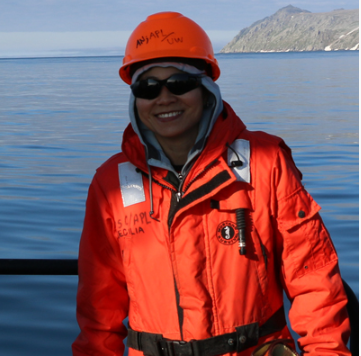It’s 2AM on the Arctic waves. The sun has yet to set and An Nguyen has yet to sleep.
“I work a lot at night,” said Nguyen, an oceanographer in the Computational Research in Ice and Ocean Systems Group (CRIOS), whose research often takes her into northern waters. “Everybody goes to bed, and I function with a couple other people on the ship to collect environmental data.”
Nguyen’s ocean voyages have taken her to some of the highest latitudes amongst CRIOS researchers and earned her the moniker, Queen of the North.
“I would have to say, the most amazing thing to watch is the sun not setting,” she said. “It simply comes toward the horizon, sits there around 2 or 3 AM, and comes right back up. We get daytime for 24 hours and when the weather is beautiful, it’s absolutely magical. One time, we captured this incredible creature with tentacles - hundreds of them! It was this shiny orange beautiful color and it hugs on to your instrument, moving around like this,” Nguyen explained with a vigorous arm wave.
“I remember one time I saw jellyfish. They were big and they were so beautiful. You almost want to drop the instrument and take a camera to capture the photo but can’t because the instrument is very expensive and is the only one you have, so you can only observe as they swim by.”
The instruments that Nguyen uses to conduct research on the high seas detect everything from water salinity to the decibels of whale song. The latter is the only music available to her at sea, but far from it when she’s on dry land.
“Pre-pandemic, I would fly directly to Europe and join many friends to go to the operas. Normally, I would go for at least three to five shows of the same opera. I am absolutely passionate about early classical music,” she enthused.
The emotional transcendence of stories being told without words was enormously appealing to Nguyen as a young researcher in a new country.
“Being an immigrant and not very versatile with languages, opera and classical music was great. I was 21 when I first heard a piece of classical music and immediately latched onto it. It was love at first sound because somehow it communicates in a way that you don't need language.”
